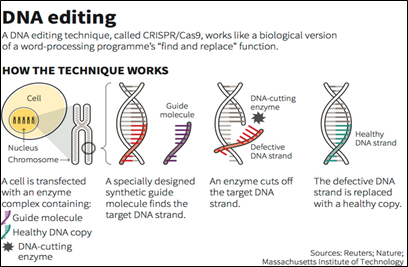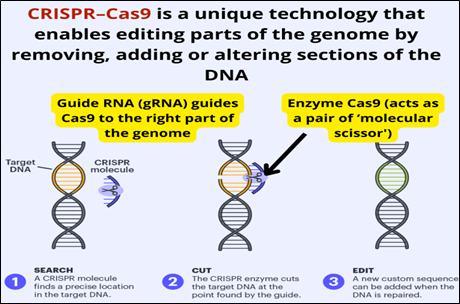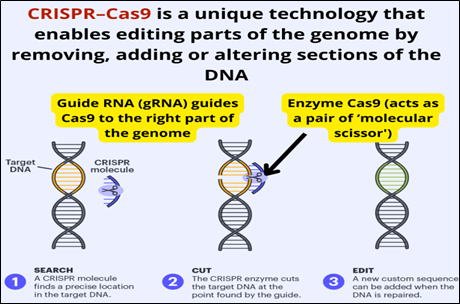

Context
Over the last few years, gene-editing technology has produced flawless results in clinical trials. India has approved a 5-year project to develop CRISPR to cure sickle cell anemia.
About
What is Genome Editing?
- Genome editing (also called gene editing) is a group of technologies that give scientists the ability to change an organism's Deoxy-Ribonucleic Acid (DNA).
- These technologies allow genetic material to be added, removed, or altered at particular locations in the genome.
- Advanced research has allowed scientists to develop the highly effective Clustered Regularly Interspaced Palindromic Repeat (CRISPR), associated proteins-based systems. This system allows for targeted intervention at the genome sequence.
- It is currently the simplest, most versatile, and most precise method of genetic manipulation and is therefore causing a buzz in the science world.

The CRISPR technology:
- CRISPR is short for Clustered Regularly Interspaced Short Palindromic Repeats, which is a reference to the clustered and repetitive sequences of DNA found in bacteria, whose natural mechanism to fight some viral diseases is replicated in this gene-editing tool.
- In popular usage, "CRISPR" (pronounced "crisper") is shorthand for "CRISPR-Cas9." CRISPRs are specialized stretches of DNA, and the protein Cas9, where Cas stands for "CRISPR-associated", is an enzyme that acts like a pair of molecular scissors, capable of cutting strands of DNA.
- CRISPR is a powerful tool for editing genomes, allowing researchers to easily alter DNA sequences and modify gene function.

How this Technology is simple from any of its predecessors?
- It is simple, and still far more accurate — and it does not involve the introduction of any new gene from the outside.
- Its mechanism is often compared to the ‘cut-copy-paste’, or ‘find-replace’ functionalities in common computer programs.
- A bad stretch in the DNA sequence, which is the cause of disease or disorder, is located, cut, removed; and then replaced with a ‘correct’ sequence.
- And the tools used to achieve this are not mechanical, but biochemical, specific protein and RNA molecules.
- The technology replicates a natural defense mechanism in some bacteria that use a similar method to protect themselves from virus attacks.
Potential of CRISPER-gene editing technology:
- Correcting genes: It open ups the possibility of ‘correcting’ genetic information to cure diseases, prevent physical deformities, or to even produce cosmetic enhancements.
- Permanent cure to genetic disorders: This technology opens up the possibility of finding a permanent cure for many of these diseases arising due to genetic disorders, like sickle-cell anemia.
- Cure to deformities due to abnormalities in gene sequences: It also works in deformities arising out of abnormalities in gene sequences, like stunted or slow growth, speech disorders, or inability to stand or walk.
|
CSIR’s Institute of Genomics and Integrative Biology has indigenously developed a CRISPR-based therapeutic solution for sickle cell anemia, which is now being readied for clinical trials. |
CRISPR: Timeline of Key Events:
- December 1987: The CRISPR mechanism was first published.
- March 2002: The term CRISPR-Cas9 was published for the first time
- March 2005: Jennifer Doudna and Jillian Banfield started investigating CRISPR.
- Nov 2005: American researchers identified new families of Cas genes which appeared to help in protecting bacteria against invading viruses.
- March 2011: Emmanuelle Charpentier and Jennifer Doudna joined forces to investigate Cas9 enzyme.
- April 2012: First commercialization of CRISPR-Cas 9 technology.
- January 2013: CRISPR-Cas is used in human genome editing.
- May 2015: The first report of genes edited in human embryos ignited the global ethical debate about gene editing technology.
- October 2015: UNESCO’s International Bioethics Committee called for a ban on genetic editing of the human germline.
- November 2015: US scientists genetically modified mosquitos using CRISPR/Cas9 to prevent them from carrying malaria parasites.
- August 2018: First CRISPR-Cas9 clinical trial launched.
- December 2018: CRISPR-Cas9 editing helped restore the effectiveness of first-line chemotherapies for lung cancer.
- October 2020: Nobel Prize in Chemistry awarded to Emmanuelle Charpentier and Jennifer Doudna 'for the development of a method for genome editing.


